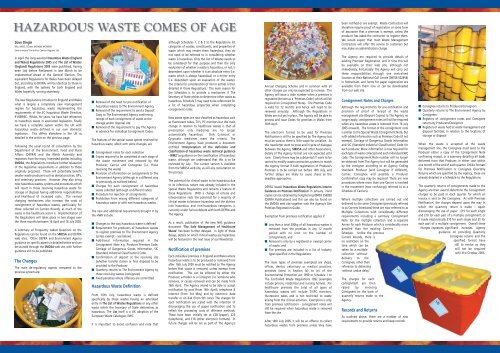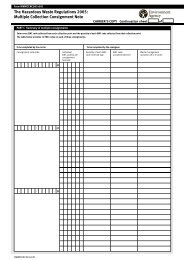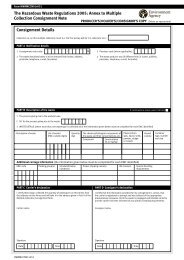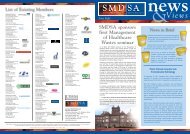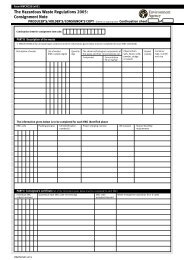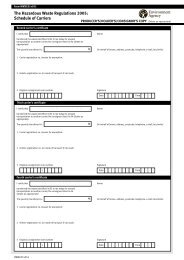&Views
SPRING 2005 8 PAGE NEWSLETTER - SMDSA
SPRING 2005 8 PAGE NEWSLETTER - SMDSA
- No tags were found...
Create successful ePaper yourself
Turn your PDF publications into a flip-book with our unique Google optimized e-Paper software.
Dave Dingle<br />
MSc, MRSC, CChem, MCIWM, MCIWEM<br />
Environmental Controller, Cannon Hygiene Ltd<br />
In April the long awaited Hazardous Waste (England<br />
and Wales) Regulations 2005 and The List of Wastes<br />
(England) Regulations 2005 were published, having<br />
been laid before Parliament in late March to be<br />
implemented ahead of the General Election. The<br />
equivalent Regulations for Wales have been delayed<br />
but, according to DEFRA, will be identical to those in<br />
England, with the systems for both England and<br />
Wales hopefully running seamlessly.<br />
The new Regulations introduce to England and Wales<br />
what is largely a completely new management<br />
regime for hazardous waste implementing the<br />
requirements of the EC Hazardous Waste Directive,<br />
91/689/EC. Whilst, for years, we have had references<br />
to hazardous waste in associated legislation, finally<br />
we have a complete system within the UK with<br />
hazardous waste defined in our own domestic<br />
legislation. This differs elsewhere in the UK as<br />
detailed in the article on the previous page.<br />
Following the usual round of consultation by the<br />
Department of the Environment, Food and Rural<br />
Affairs (DEFRA) and the Welsh Assembly and<br />
responses from the many interested parties including<br />
SMDSA, the Regulations introduce further relaxation<br />
of the legislative requirements in addition to those<br />
originally proposed. These will potentially benefit<br />
smaller waste producers such as dental practices, GP’s,<br />
and veterinary practices. However they also bring<br />
new hazardous wastes, systems and procedures which<br />
will result in those receiving hazardous waste for<br />
storage or disposal having additional responsibilities<br />
and likelihood of increased costs. The revised<br />
charging mechanisms also increase the costs of<br />
consignment of hazardous wastes, particularly for<br />
those collected on Carriers Rounds, as much of the<br />
waste in the healthcare sector is. Implementation of<br />
the Regulations will takes place in two stages over<br />
the three months between 16 April and 16 July 2005.<br />
A summary of Frequently Asked Questions on the<br />
Regulations can be found on the SMDSA and DEFRA<br />
web sites. Other DEFRA and Environment Agency<br />
guidance on specific aspects is detailed below and can<br />
be sourced through the SMDSA web site, with further<br />
guidance still to be published.<br />
The Changes<br />
The main de-regulatory aspects compared to the<br />
previous system are:<br />
■ Removal of the need for pre-notification of<br />
hazardous wastes to The Environment Agency<br />
■ Removal of the requirement to send a Deposit<br />
Copy to The Environment Agency confirming<br />
receipt of each consignment of waste at the<br />
storage and/or disposal site.<br />
■ Removal of the requirement to pay The Agency<br />
in advance for individual Consignment Codes.<br />
The features of the special waste system retained for<br />
hazardous waste, albeit with some changes, are<br />
■ Consignment notes for each collection<br />
■ Copies required to be completed at each stage of<br />
the waste movement and retained by the<br />
Producer, Carrier and Consignee (i.e. those<br />
receiving the waste)<br />
■ Provision of information on consignments to The<br />
Environment Agency (although in a different way<br />
to previously, as outlined below)<br />
■ Charges for each consignment of hazardous<br />
waste collected (although at different rates).<br />
■ Procedure for rejection of consignments<br />
■ Prohibition from mixing different categories of<br />
hazardous waste or with non-hazardous wastes.<br />
The new and additional requirements brought in by<br />
the HWR include:<br />
■ Changes to the way hazardous waste is defined<br />
■ Requirement for producers of hazardous wastes<br />
to register premises to The Environment Agency<br />
(unless exempt – see below)<br />
■ Additional information required in the<br />
Consignment Note e.g. Producer Premises Code,<br />
Carriage of Dangerous Goods information, SIC<br />
(Standard Industrial Classification) Code.<br />
■ Confirmation of deposit at the receiving site<br />
(whether transfer station or final disposal) to be<br />
provided to the Producer<br />
■ Quarterly returns to The Environment Agency by<br />
those receiving wastes (consignees)<br />
■ Fixed penalties where offences are committed<br />
Hazardous Waste Definition<br />
From 16th July, hazardous waste is defined<br />
specifically by those wastes having an asterisked<br />
entry in The List of Wastes Regulations or any other<br />
waste which the Secretary of State determines as<br />
hazardous. The List itself is a UK adoption of the<br />
European Waste Catalogue, EWC.<br />
It is important to avoid confusion and note that<br />
although Schedules 1, 2 & 3 to the Regulations list<br />
categories of wastes, constituents, and properties of<br />
waste which may render them hazardous, they do<br />
not need to be referred to in considering whether<br />
waste is hazardous. Only the List of Wastes needs to<br />
be considered for that purpose and then the only<br />
evaluation of whether a waste is hazardous, or not, is<br />
dependent upon whether it is an absolute entry (i.e.<br />
waste which is always hazardous) or a mirror entry<br />
(i.e. dependent upon an evaluation of the waste).<br />
The criteria for consideration of mirror entries is then<br />
detailed in those Regulations. The main reason for<br />
the Schedules is to provide a mechanism if The<br />
Secretary of State wishes to determine other waste as<br />
hazardous. Schedule 3 may need to be referenced for<br />
a list of hazardous properties when completing<br />
consignment notes.<br />
New waste types are now classified as hazardous such<br />
as fluorescent tubes, TV’s, PC monitors but the main<br />
change in relation to healthcare wastes is that all<br />
prescription only medicines are no longer<br />
automatically hazardous. Only Cytotoxic or<br />
Cytostatic medicines meet the criteria. The<br />
Environment Agency have produced a document<br />
entitled ‘Interpretation of the definition and<br />
classification of hazardous waste technical guidance<br />
- WM2’ as guidance on the classification of hazardous<br />
waste, although we understand that this is to be<br />
reviewed by July. The current version is available<br />
from the SMDSA web site, as will any consultation on<br />
the process.<br />
The potential for clinical waste to be hazardous due<br />
to its infectious nature was already included in the<br />
Special Waste Regulations and remains a feature of<br />
these Regulations. With a change of criteria and<br />
interpretation rests the potential for a majority of<br />
clinical wastes to become hazardous and the division<br />
into hazardous and non-hazardous categories is<br />
currently under furious debate with both DEFRA and<br />
The Agency.<br />
As a result, publication of the new NHS guidance<br />
document ‘The Safe Management of Healthcare<br />
Waste’ has been further delayed. In light of these<br />
delays, details on which clinical wastes are hazardous<br />
will be featured in the next issue of our Newsletter.<br />
Notification of premises<br />
Each individual premises in England and Wales where<br />
hazardous waste is to be produced or removed from<br />
after 16th July 2005 must be notified to The Agency<br />
before that waste is removed, unless exempt from<br />
notification. This can be effected by either the<br />
Producer, a Holder or a Consignor (i.e. someone who<br />
removes, or causes removal) and can be made from<br />
16th April. The Agency intend to be able to accept<br />
notification by post (from 16th April), telephone &<br />
internet (from 3rd May) and by electronic data<br />
transfer or on disk (from 9th June). The charges for<br />
each notification are scaled with the intention of<br />
discouraging the use of paper notification and to<br />
reflect the processing costs of different methods.<br />
These have been initially set at £28 (paper), £23<br />
(telephone), and £18 (other electronic formats). In<br />
future charges will be set as part of The Agency’s<br />
Annual Charging Scheme and in common with all<br />
other charges can only be expected to increase. The<br />
Agency will issue a code number when a premises is<br />
registered (known as a ‘Premises Code’) which will be<br />
required on Consignment Notes. The Premises Code<br />
is valid for 12 months and hence will need to be<br />
renewed annually. Although the Regulations in<br />
Wales are not yet in place, The Agency will be able to<br />
process and issue Codes for premises in Wales from<br />
16th April.<br />
The electronic format to be used for Premises<br />
Notification is still to be specified by The Agency but<br />
must be used so there is little scope for variation. As<br />
this newsletter went to press and in spite of dialogue<br />
between the Agency, SMDSA and other Associations,<br />
details of The Agency format are not expected until<br />
June. Clearly there may be substantial IT work to be<br />
carried to modify waste contractors systems to match<br />
the Agency format if bulk registration of Producers<br />
Premises is to be carried out before 16th July, and<br />
further delays are likely to cause chaos as the<br />
deadline approaches.<br />
DEFRA issued ‘Hazardous Waste Regulations Interim<br />
Guidance on Premises Notification’ in January. Hard<br />
copies can be obtained by telephoning 08459 556000<br />
(DEFRA Publications) and this can also be found on<br />
the SMDSA web site together with the Agency’s Site<br />
Premises Registration Guide.<br />
Exemption from premises notification applies if<br />
■ Less than a total 200kg of all hazardous wastes is<br />
removed from the premises in any 12 month<br />
period with no limit on the number of<br />
consignments, and<br />
■ Removal is only by a registered or exempt carrier<br />
of waste, and<br />
■ The premises are included in a list of industry<br />
types specified in the Regulations<br />
The main types of premises exempted are shops,<br />
offices, dental, veterinary or medical practices,<br />
premises listed in Section (a) to (e) of the<br />
Environmental Protection Act 1990 or Schedule 1 to<br />
The Controlled Waste Regulations 1992 (examples<br />
include prisons, residential and nursing homes). For<br />
healthcare premises the total of all types of<br />
hazardous wastes will include TV/PC monitors,<br />
fluorescent tubes and is not restricted to waste<br />
arising from the clinical activities. Exemption is only<br />
from premises notification - consignment notes will<br />
still be required when hazardous waste is removed<br />
from the site.<br />
After 16th July 2005, it will be an offence to collect<br />
hazardous wastes from premises unless they have<br />
been notified or are exempt. Waste Contractors will<br />
therefore require proof of registration or some form<br />
of assurance that a premises is exempt, unless the<br />
producer has asked the contractor to register them.<br />
We would expect that most Waste Management<br />
Contractors will offer this service to customers but<br />
may make an administration charge.<br />
The Agency are required to provide details of<br />
existing Premises’ Registration, and in time this will<br />
be available on their web site, although not<br />
immediately. Fortunately The Agency will carry out<br />
these responsibilities through one centralised<br />
location at their National Call Centre (08708 502858)<br />
in Rotherham, and forms for paper registration are<br />
available from them now or can be downloaded<br />
from our web site.<br />
Consignment Notes and Charges<br />
Although the requirements for pre-notification and<br />
provision of proof of receipt at the waste<br />
management site (Deposit Copies) to The Agency no<br />
longer apply, consignment notes will still be required<br />
when any hazardous waste is removed from 16 July<br />
2005 onwards. The format of the consignment note<br />
is similar to the Special Waste Consignment Note, but<br />
with added information such as Premises Code (if not<br />
exempt), Carriage of Dangerous Goods information<br />
and SIC (Standard Industrial Classification) Code for<br />
each producer. More information is now required for<br />
each type of waste collected and each individual EWC<br />
code. The Consignment Note number will no longer<br />
be obtained from The Agency but will be generated<br />
by the consignor according to an Agency Coding<br />
Standard. Producer (and Consignor if different),<br />
Carrier, Consignee and possibly a Producer<br />
Confirmation copy may be required. There are new<br />
procedures where more than one Carrier is involved<br />
in the movement (now confusingly referred to as a<br />
Schedule of Carriers).<br />
Where multiple collections are carried out and<br />
delivered to the same Consignee (previously referred<br />
to as Carriers Schedules) these are now referred to as<br />
Multiple Collections with considerably different<br />
requirements including a summary Consignment<br />
Note for the multiple collection and a separate<br />
Annex for each Producer which is considerably more<br />
detailed than the existing Carriers<br />
Schedule. Unlike the previous<br />
Carriers Rounds, there is<br />
no restriction on the<br />
time which can be<br />
taken for a multiple<br />
collection without<br />
delivery to the<br />
Consignee, other than<br />
reference to delivering<br />
‘without undue delay’.<br />
The charges for each<br />
consignment are then<br />
raised by invoicing<br />
Consignees on the basis of<br />
quarterly returns made to the<br />
Agency.<br />
Records and Returns<br />
As outlined above, there are a number of new<br />
requirements to provide returns and keep records:<br />
■ Consignee returns to Producers/Consignors<br />
■ Quarterly returns to The Environment Agency by<br />
Consignees<br />
■ Registers of consignment notes and Consignee<br />
returns by Producers/Consignors<br />
■ Registers of waste held at waste management and<br />
disposal facilities, in relation to the locations of<br />
storage or disposal<br />
When the waste is accepted at the waste<br />
management site, the Consignee must send to the<br />
Producer either a copy of the Consignment Note<br />
confirming receipt, or a summary detailing all loads<br />
delivered from that Producer, in either case within<br />
one month of the end of each quarter. Unlike formats<br />
for Premises Notification or Consignee Quarterly<br />
Returns which are specified by the Agency, these are<br />
already detailed in a Schedule to the Regulations.<br />
The quarterly returns of consignments made to the<br />
Agency are then used to determine the Consignment<br />
charges to be paid in each quarter for which an<br />
invoice is sent to the Consignee. As with Premises<br />
Notification, the charges depend upon the way in<br />
which the quarterly return is made – again<br />
discouraging the use of paper -.£19 for each single<br />
and £10 for each part of a multiple consignment; or<br />
if made electronically £10 for each single and £5 for<br />
each part of a multiple consignment. Overall these<br />
charges represent significant increases. Agency<br />
guidance on providing Quarterly<br />
Consignee returns and the<br />
specified format have<br />
still to evolve as they<br />
will not be required<br />
until 31st October 2005.


